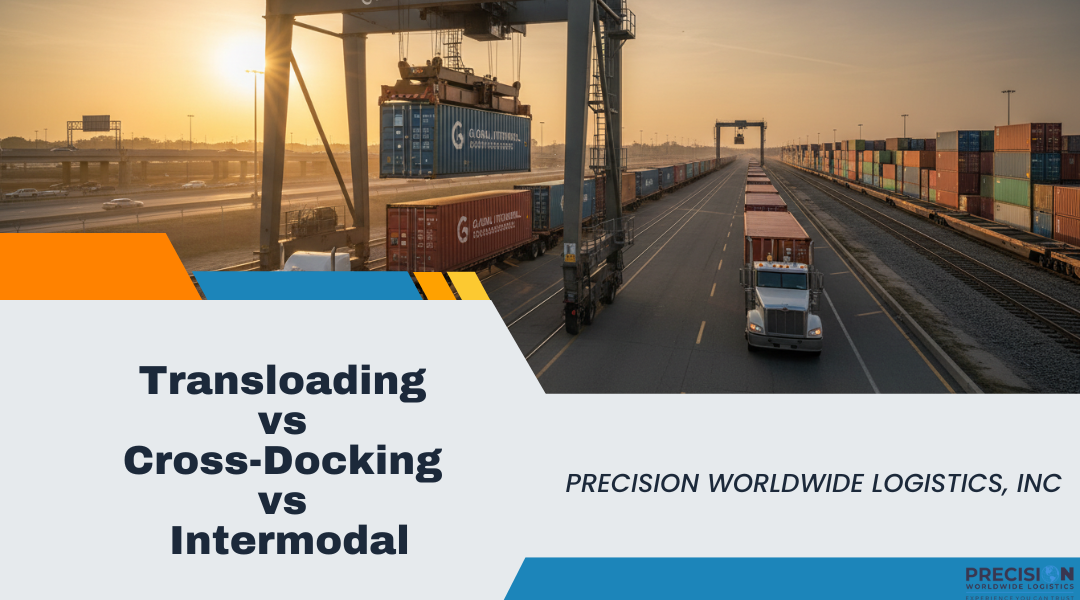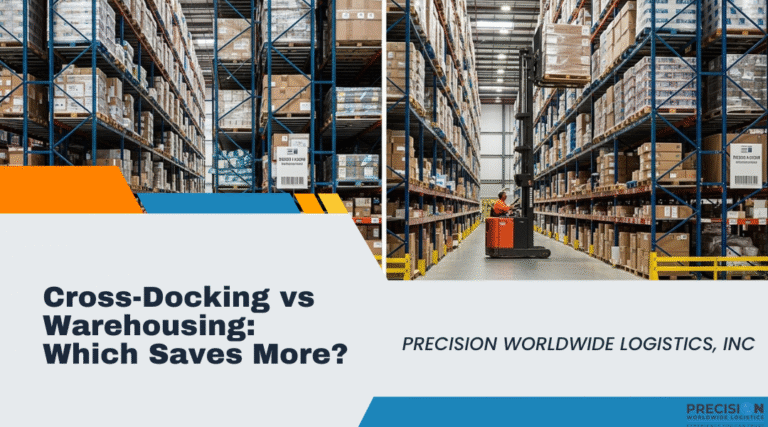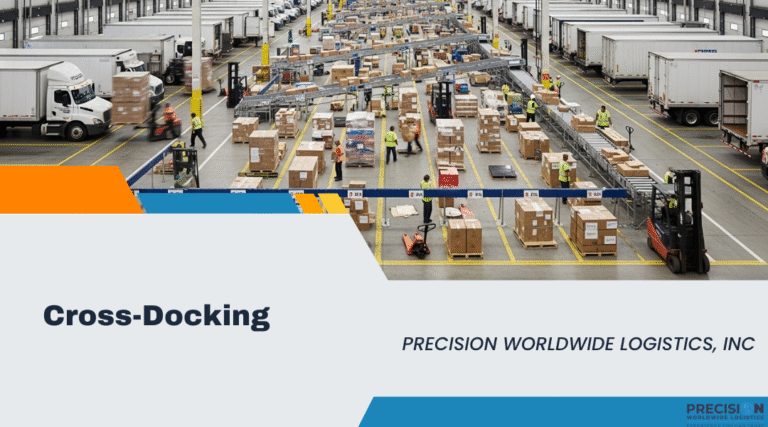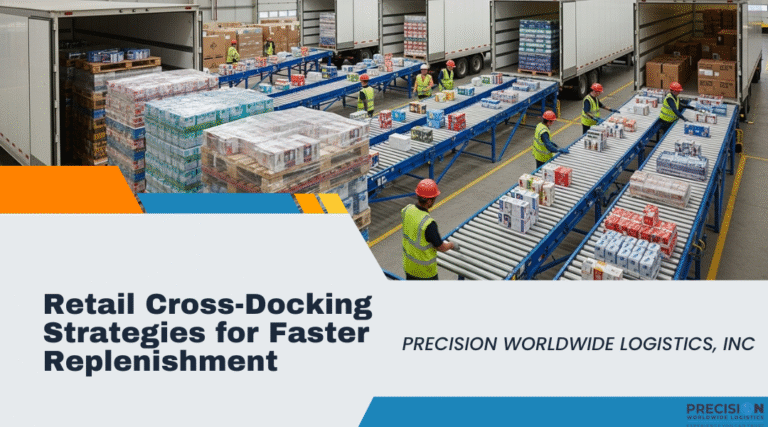Navigating the logistics industry means wading through terminology that sounds similar but describes distinctly different operations. Three of the most commonly confused concepts—transloading, cross-docking, and intermodal shipping—each serve unique purposes in modern supply chains. Choosing the wrong approach can cost you time and money, while selecting the right one can transform your logistics efficiency.
If you’ve ever wondered whether your shipment needs transloading, cross-docking, or intermodal service (or found yourself using these terms interchangeably), this guide will clarify the differences and help you make the best choice for your freight.
Quick Comparison Overview
| Feature | Transloading | Cross-Docking | Intermodal |
| Primary Purpose | Mode transfer & optimization | Rapid distribution | Seamless mode switching |
| Freight Handling | Unload, repack, reload | Minimal touch, direct transfer | Container stays sealed |
| Storage Time | Hours to 1-2 days | Hours only | N/A (in transit) |
| Modes Involved | Switch between modes | Same mode (usually truck-to-truck) | Multiple modes, same container |
| Best For | International imports, mode optimization | Retail distribution, consolidation | Long-haul with direct routing |
Now let’s dive deeper into each strategy.
What is Transloading?
Transloading is the process of transferring freight from one transportation mode to another—most commonly from ships or railcars to trucks, though any mode combination is possible.
How Transloading Works
- Cargo arrives at a transload facility via ocean container, rail, or truck
- Goods are unloaded from their original container or trailer
- Freight is sorted, often repalletized, and potentially split or combined with other shipments
- Cargo is loaded onto different transportation equipment for the next leg
Key Characteristics
- Mode switching: The defining feature—moving freight between different transport types
- Physical handling: Goods are touched, sorted, and repackaged as needed
- Optimization opportunity: Ability to consolidate, split, or reconfigure loads
- Brief facility time: Typically processes within hours to a day or two
When to Use Transloading
✓ Importing goods through major ports: Especially relevant for West Coast ports like LA/Long Beach, where ocean freight transitions to domestic truck or rail
✓ Long-haul cost optimization: Use economical rail across country, then transload to trucks for final delivery
✓ Shipment consolidation needs: Combine multiple smaller shipments into full truckloads to reduce per-unit costs
✓ Destination splitting: One inbound container serves multiple delivery locations
✓ Specialty equipment transitions: Moving from standard containers to refrigerated trucks, flatbeds, or other specialized equipment
Real-World Transloading Example
A furniture importer receives a 40-foot container of home goods from Vietnam at the Port of Long Beach. The container holds products for three different retail chains across the western U.S.
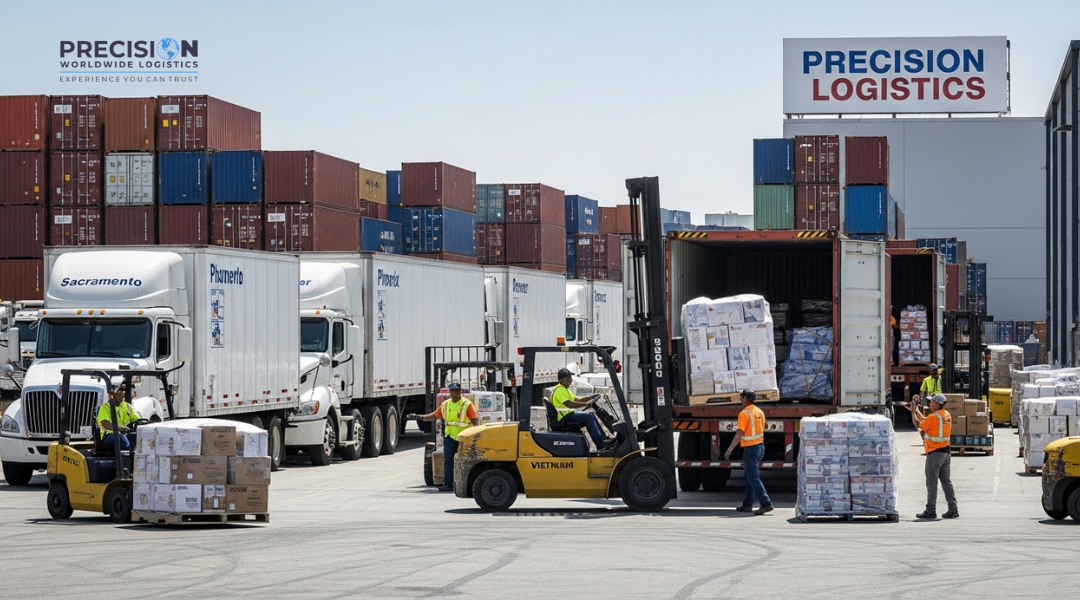
At a nearby transload facility, the container is unloaded and sorted into three separate truckloads—one heading to a distribution center in Sacramento, another to Phoenix, and the third to Denver. Each truck departs within 24 hours of the container’s arrival, delivering products days faster than traditional warehousing while eliminating the cost of shipping a third-full container to each destination.
What is Cross-Docking?
Cross-docking is a distribution strategy where incoming freight is directly transferred to outbound transportation with little or no storage in between—typically truck-to-truck within a distribution center.
How Cross-Docking Works
- Inbound trucks arrive at a cross-dock facility with consolidated freight
- Goods are quickly sorted by destination while still on original pallets
- Freight moves directly across the dock to waiting outbound trucks
- Outbound trucks depart, often within hours of inbound arrival
Key Characteristics
- Same mode: Usually truck-to-truck (though can involve other combinations)
- Minimal handling: Goods typically stay on original pallets, just move from one dock door to another
- Speed-focused: The goal is reducing time between receipt and delivery to hours
- Pre-planned: Requires precise coordination and advance planning
When to Use Cross-Docking
✓ Retail replenishment: Getting products from distribution centers to stores quickly
✓ Consolidation centers: Combining less-than-truckload (LTL) shipments into full truckloads for specific regions
✓ Time-sensitive freight: Perishables, just-in-time manufacturing components, or promotional items
✓ High-velocity products: Fast-moving consumer goods that don’t need warehouse storage
✓ Domestic distribution: Most common in same-country logistics where shipments don’t require mode changes
Real-World Cross-Docking Example
A national grocery chain operates a cross-dock facility serving 50 stores in a metropolitan area. Inbound trucks from various food manufacturers arrive throughout the morning, each carrying mixed products. Workers immediately sort items by destination store, moving pallets across the dock to store-specific outbound trucks. By afternoon, each truck departs with a fully curated load for its designated store—achieving overnight replenishment without holding inventory.
What is Intermodal Shipping?
Intermodal shipping transports freight using multiple modes of transportation—truck, rail, and/or ship—while keeping cargo in the same container throughout the entire journey. The container itself moves between modes; the contents are never unloaded until final destination.
How Intermodal Works
- Freight is loaded into a standardized container (usually 20′, 40′, or 53′)
- Container moves via truck (drayage) to rail terminal
- Container is lifted onto rail car for long-haul segment
- At destination rail terminal, container is transferred back to truck chassis
- Final truck delivery to destination—freight never left the original container
Key Characteristics
- Sealed container: Cargo isn’t touched between origin and destination
- Equipment transfer: The container moves between modes; contents don’t
- Standardization: Relies on ISO container standards compatible across modes
- Security: Reduced theft/damage risk since container remains sealed
- Less flexibility: Can’t split or combine loads mid-journey
When to Use Intermodal
✓ Long-haul domestic shipping: Especially coast-to-coast or distances over 750 miles where rail economics shine
✓ Shipments staying intact: When your container size and contents match needs from origin to final destination
✓ Security-sensitive freight: High-value goods benefit from sealed-container protection
✓ Environmental priorities: Rail produces significantly less CO2 than long-haul trucking
✓ Capacity constraints: When truck capacity is tight, intermodal provides alternatives
Real-World Intermodal Example
An auto parts manufacturer in Detroit ships components to an assembly plant in Los Angeles. Parts are loaded into a 53-foot container at the Detroit factory. A truck moves the container to a nearby rail terminal. The sealed container travels by rail across the country (taking 5-7 days but at lower cost than trucking). In Los Angeles, the container is transferred to a truck chassis and delivered directly to the assembly plant—never opened until arrival.
Transloading vs. Cross-Docking: Key Differences
While both minimize storage time, they serve different purposes:
| Aspect | Transloading | Cross-Docking |
| Mode change? | Yes—that’s the point | Usually no (same mode) |
| Freight handling | Significant—unload, sort, repack | Minimal—stay on pallets |
| Geography | Often at ports or modal transfer points | Distribution centers, inland |
| Primary benefit | Mode optimization & flexibility | Speed through supply chain |
| International vs. domestic | Often international | Primarily domestic |
Choose transloading when: You need to switch transportation modes, optimize loads, or handle international freight arriving at ports.
Choose cross-docking when: You’re moving domestic freight quickly through distribution without needing mode changes, and speed matters more than load optimization.
Transloading vs. Intermodal: Key Differences
Both involve multiple transportation modes, but the approach differs fundamentally:
| Aspect | Transloading | Intermodal |
| Container status | Opened and unloaded | Stays sealed throughout |
| Flexibility | High—can split, combine, repack | Low—container stays as-is |
| Handling complexity | More touches, more risk | Fewer touches, less risk |
| Cost structure | Labor-intensive but optimizable | Equipment-focused, fixed container size |
| Speed | Can be faster with near-port facilities | Depends on rail schedules |
Choose transloading when: You need to consolidate, split, or optimize loads; shipments serve multiple destinations; or you’re importing through major ports and need immediate distribution.
Choose intermodal when: Your shipment fits efficiently in a standard container size, can stay intact throughout the journey, and you’re shipping long distances domestically.
Cross-Docking vs. Intermodal: Key Differences
These two are less commonly confused but worth distinguishing:
| Aspect | Cross-Docking | Intermodal |
| Purpose | Rapid redistribution | Cost-effective long-haul |
| Facility type | Distribution center with multiple docks | Rail terminals + truck drayage |
| Time in facility | Hours | N/A (container in transit) |
| Load changes | Common (consolidation/deconsolidation) | Rare (sealed unit) |
Choose cross-docking when: Speed of distribution is critical and you’re working within a regional network.
Choose intermodal when: Distance and cost-efficiency drive decisions, and you can wait for scheduled rail movements.
Can You Combine These Strategies?
Absolutely! Sophisticated supply chains often use multiple approaches:
Intermodal + Transloading: A container travels intermodally (ship + rail) from Asia to a Chicago rail terminal, then is transloaded at a nearby facility where contents are sorted into regional truck shipments.
Transloading + Cross-Docking: Import containers are transloaded at a port facility, then some of that freight moves through a cross-dock operation for final local distribution.
All Three: International freight arrives via ship (intermodal component), is transloaded near the port from containers to trucks, then flows through a cross-dock facility for final sorting to retail locations.
Making the Right Choice for Your Business
Consider these factors when selecting your freight strategy:
Choose TRANSLOADING if:
- You’re importing through major ports and need immediate distribution
- Shipment optimization (splitting/combining) would save significant costs
- You need to switch between transportation modes
- Your cargo serves multiple final destinations
- You want to leverage different modes’ cost advantages (cheap rail + flexible truck)
Choose CROSS-DOCKING if:
- You’re distributing domestically with tight delivery windows
- Speed matters more than load optimization
- You have predictable freight flows that can be pre-planned
- You’re consolidating LTL shipments into full truckloads
- Your operation focuses on retail or just-in-time delivery
Choose INTERMODAL if:
- You’re shipping long distances (especially coast-to-coast)
- Your freight fits efficiently into standard container sizes
- Shipments can stay intact from origin to destination
- Cost savings outweigh longer transit times
- Security and reduced handling are priorities
Southern California Considerations
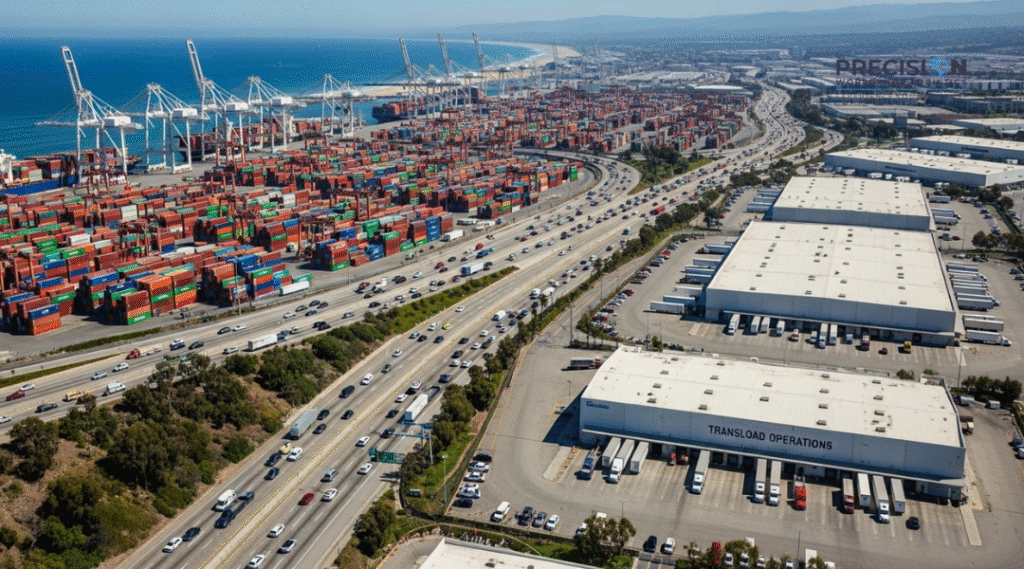
For businesses operating in the Los Angeles/Long Beach port region, transloading offers unique advantages:
- Geographic necessity: International imports must transition from ocean to domestic modes—transloading is often required, not optional
- Proximity advantage: Near-port transload facilities (like Precision’s La Mirada location) dramatically reduce drayage costs and port congestion exposure
- Speed to market: For serving West Coast customers, rapid transloading beats slower intermodal rail alternatives
- Flexibility: SoCal’s position as a distribution gateway makes load optimization through transloading especially valuable
Partner with Transloading Experts
Understanding these logistics strategies is the first step—implementing them effectively requires experienced partners with the right infrastructure and location.
At Precision Worldwide Logistics, our transloading facilities less than 30 minutes from the Port of LA/Long Beach combine:
- Strategic location for minimal drayage
- Asset-based operations (our own trucks and equipment)
- 25+ years of port logistics experience
- Integrated services (warehousing, distribution, fulfillment)
Whether you need transloading, have questions about the best approach for your freight, or want to optimize your existing supply chain, our team is ready to help.
Contact Precision Worldwide Logistics:
📞 (800) 937-1599
✉️ [email protected]
Final Thoughts
Transloading, cross-docking, and intermodal shipping each play vital roles in modern logistics. Rather than thinking of them as competing options, consider them tools in your supply chain toolkit—each valuable for specific situations.
The key is understanding your freight characteristics, delivery requirements, cost priorities, and geographic factors. With that knowledge, you can select the approach—or combination of approaches—that optimizes your supply chain performance.
Have questions about which strategy fits your business? Our logistics experts are standing by to provide personalized guidance. Reach out today for a free consultation.

